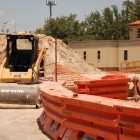Background
With its large population and energy-intensive economy, Texas leads the nation in energy consumption, accounting for more than one-tenth of total U.S. energy use. Buildings alone account for 40 percent of total energy usage and 70 percent of electric power use. The State Energy Conservation Office (SECO) enforces Texas Building Energy Efficiency Performance Standards to ensure buildings are constructed with energy efficient elements.
Texas recently adopted new building code standards for both residential and non-residential buildings. Effective January 1, 2012, SECO officially requires all new single-family homes in Texas to comply with the energy efficiency provisions of the 2009 International Residential Code (IRC). As of April 1, 2011, all other residential, commercial, and industrial construction must meet the provisions of the 2009 International Energy Conservation Code (IECC). While the IRC and IECC do not call for equivalent energy saving measures, the two are similar. States can adopt the IRC, the IECC, or both. Both of these codes are written by the International Code Council.
Under the American Recovery and Reinvestment Act, Texas agreed to enforce building code standards equal to or stricter than the 2009 IECC with a 90 percent compliance rate throughout the state by 2017. Adhering to these measures will cut energy use by up to 15 percent in new homes. Environment Texas, a citizen-based environmental organization, conducted a study suggesting that energy savings could be even greater.
Before these regulations were adopted, four major cities in Texas—Austin, Dallas, Houston, and San Antonio—each developed and adhered to their own building codes. (For example, Austin used the 2006 IECC with significant amendments to improve energy efficiency.) The new codes allow for more regularity across the state. SECO provides a detailed history of Texas’ building codes from 1989 to the present.
The 2009 IRC calls for numerous new changes, including: the installation of fire sprinklers in all townhouses and one- and two-family dwellings; the installation of carbon monoxide alarms outside of all sleeping areas; an increase in the amount of wall bracing to protect against strong winds in three-story homes or homes in high-wind regions; a fire separation distance of three feet between walls; a minimum side clearance between bathtubs of 12 inches; and the addition of fall protection devices in emergency exit windows. Other changes defined by the 2009 IRC are listed here.
Under the new 2009 IECC changes, Texas is divided into three separate climate zones to determine the minimum energy efficiency requirements in each region. Some provisions of the code are prescriptive, meaning they are required, but details vary by climate zone. Others are mandatory and do not alter based on location. For residential construction, the 2009 IECC makes adjustments to fenestration and skylight U-factors, basement wall and ceiling R-values, insulation guidelines, air duct pressure testing, building thermal envelope caulking procedures, in addition to other changes. The 2009 IECC requires that heated pools be covered to avoid energy loss from evaporation and that 50 percent of bulbs in light-fixtures be energy efficient. An overview of the code can be found here.
After construction, the 2009 IECC requires buildings to be tested, either by a whole-house blower door test or an extensive code inspection. The code includes different provisions for commercial buildings, depending on their thermal envelope, mechanical systems, water heating, power and lighting design.

